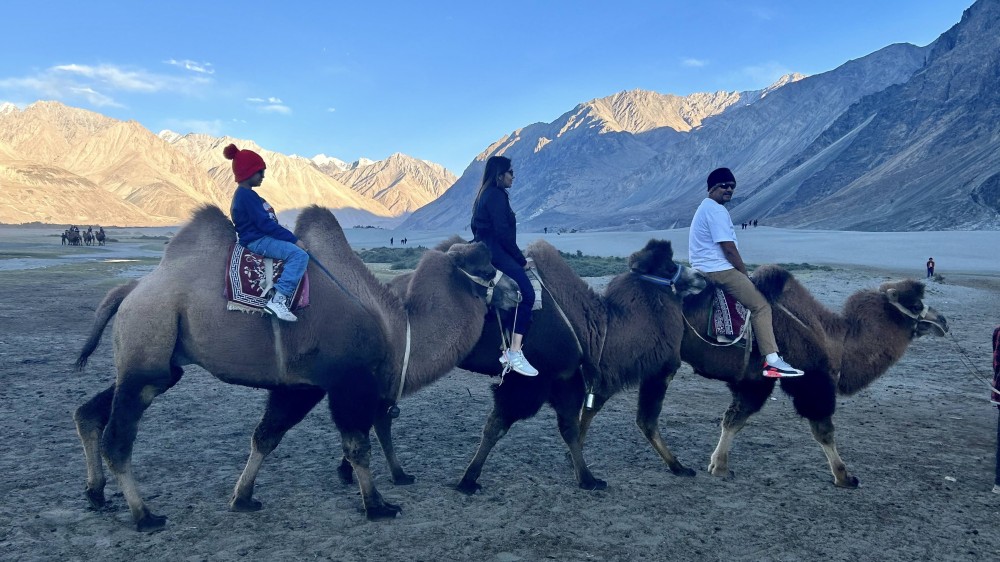
These beautiful dunes of the sand are believed to have originated from a flood caused back in the 1920's, known among locals as the Khumdan Floods. These dunes keep on shifting at the whim of the staggering wind storms that rise almost every evenings. The locals in the region rear and breed a very unique species of a camel known to the world as the Bactrian camel. These camels have double hump as compared to the usual camels with a single hump. Bactrian camels are also known as the Mongolian camel, native to the steppes of the Central Asia. They appeared in Ladakh for the first time with the travellers travelling from Central Asia during the flourishing times of the Silk Route. And since then, they have been born and bred in Ladakh. With closure of the ancient routes and the borders, these camels of Hunder are the last of their survival history. In present times, the locals own them for two reasons; they can feed on the thorny bushes of seabuckthorn and they are source of income during the summers as they serve as ride for the tourists visiting the valley.
Hunder has one of the most exquisite royal residence "Hunder Zimskhang", known to a very few people about its existence and its importance. Nubra is considered to be warmer than Leh during the winters and hence the royals would usually shift to their winter capitals during the winters. After the demise of the king Jamyang Namgyal in 1616 A.D, his widow queen rGyal Khatoon (a famous muslim princess known for introducing a peaceful and secular Ladakh) resided in this very royal abode. She took her last breaths within the same walls of Hunder Zimskhang and finally she was buried there itself. It is believed that the floods of 1920's "Khumdan Floods", also washed away her tomb, forever to be lost in times and space. The ground level of this building was also flooded and what we can witness today is the remaining upper storeys. If you ever gain the opportunity to visit Hunder then do not just stuck by the dunes and its beauty, do pay a visit to this magnificent abode of the royals. The building itself echoes of the good old days and its wooden designs and its carvings are all influenced from the Central Asia. The small prayer chamber inside this building also consist of one of the oldest Buddhist Scripture, written with golden ink believed to have been imported from Tibet by the royals. It is rare that this will be displayed to the tourists though.
Deskit is the present capital of the Nubra valley and it lies 30 km away from Hunder. Deskit has the main Government offices and Health Care stations of the valley. Among the tourists, it is famous for its monastery the Deskit Gonpa which was founded by Changzem Tserab Zangpo in the 14th century. He was a devout disciple of the great Tsong Khapa, the founder of the Yellow Sect or Gelugpa school of thought. Long back in the history, this area was affected with a spread of leprosy epidemic. Leprosy in local dialect is called "dZe" and so, the region came to be known as dZeskit, a combination of two words; dZe- leprosy, skit-hppiness. The epidemic was very harsh and it almost brought the population at the brink of extinction. There was a a very holy statue of the Tsongkhapa in the monastery which started to melt away at its nose as if it'd been infected by the leprosy. The epidemic came to an end after the episode of this melting statue and since then, the locals came to believe that the statue took the disease on itself and saved the lives of the remaining people. Once again the valley flourished and the epidemic became history so, the locals renamed their village as De-skit which is again a combination of two words; De- prefix of the word Dewa which means peace and skit means happiness. One can witness the same statue even today, placed under the same roof of the Deskit Monastery. Therefore, do not miss on this monastery.
Indeed, Nubra is a valley filled with mysterious folk tales and historical tales.